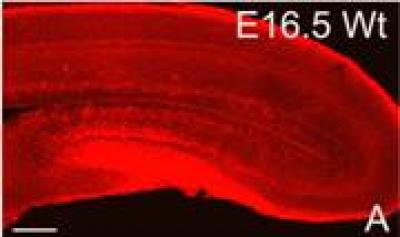Cajal-Retzius cell loss and amyloidosis in Alzheimer's disease

Cajal-Retzius cells were observed in the molecular layer of the dentate gyrus as early as embryonic day 16.5, and were densely concentrated in the molecular layer of the dentate gyrus (immunohistochemical analysis). Credit: Neural Regeneration Research
However, the relationship between Cajal-Retzius cells and Alzheimer's disease is unknown.
Dr. Jinbo Deng and team from Henan University in China revealed that the number of Cajal-Retzius cells markedly reduced with age in both wild type and in mice over-expressing the Swedish double mutant form of amyloid precursor protein 695 (transgenic (Tg) 2576 mice).
The decline in Cajal-Retzius cells in Tg2576 mice was found to occur concomitantly with the onset of Alzheimer's disease amyloid pathology and related behavioral defcits.
Overall, these data, published in the Neural Regeneration Research (Vol. 9, No. 4, 2014), indicated that Cajal-Retzius cell loss occurred with the onset and development of Alzheimer's disease.
Article: ” Characterization of hippocampal Cajal-Retzius cells during development in a mouse model of Alzheimer's disease (Tg2576),” by Dongming Yu1, Wenjuan Fan2, Ping Wu1, Jiexin Deng1, Jing Liu1, Yanli Niu1, Mingshan Li1, Jinbo Deng1 (1 Institute of Neurobiology, School of Life Science, Henan University, Kaifeng, Henan Province, China; 2 Laboratory of Molecular Medicine, Luohe Medical College, Luohe, Henan Province, China)
Yu DM, Fan WJ, Wu P, Deng JX, Liu J, Niu YL, Li MS, Deng JB. Characterization of hippocampal Cajal-Retzius cells during development in a mouse model of Alzheimer's disease (Tg2576). Neural Regen Res. 2014;9(4):394-401.
Contact:
Meng Zhao
eic@nrren.org
86-138-049-98773
Neural Regeneration Research
http://www.nrronline.org/
Media Contact
All latest news from the category: Life Sciences and Chemistry
Articles and reports from the Life Sciences and chemistry area deal with applied and basic research into modern biology, chemistry and human medicine.
Valuable information can be found on a range of life sciences fields including bacteriology, biochemistry, bionics, bioinformatics, biophysics, biotechnology, genetics, geobotany, human biology, marine biology, microbiology, molecular biology, cellular biology, zoology, bioinorganic chemistry, microchemistry and environmental chemistry.
Newest articles

Trotting robots reveal emergence of animal gait transitions
A four-legged robot trained with machine learning by EPFL researchers has learned to avoid falls by spontaneously switching between walking, trotting, and pronking – a milestone for roboticists as well…

Innovation promises to prevent power pole-top fires
Engineers in Australia have found a new way to make power-pole insulators resistant to fire and electrical sparking, promising to prevent dangerous pole-top fires and reduce blackouts. Pole-top fires pose…

Possible alternative to antibiotics produced by bacteria
Antibacterial substance from staphylococci discovered with new mechanism of action against natural competitors. Many bacteria produce substances to gain an advantage over competitors in their highly competitive natural environment. Researchers…





















